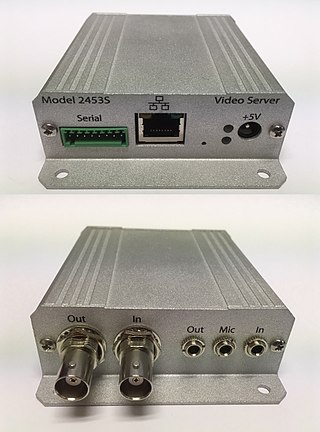Windows Media Audio (WMA) is a series of audio codecs and their corresponding audio coding formats developed by Microsoft. It is a proprietary technology that forms part of the Windows Media framework. WMA consists of four distinct codecs. The original WMA codec, known simply as WMA, was conceived as a competitor to the popular MP3 and RealAudio codecs. WMA Pro, a newer and more advanced codec, supports multichannel and high resolution audio. A lossless codec, WMA Lossless, compresses audio data without loss of audio fidelity. WMA Voice, targeted at voice content, applies compression using a range of low bit rates. Microsoft has also developed a digital container format called Advanced Systems Format to store audio encoded by WMA.

Windows Media Player (WMP) is the first media player and media library application that Microsoft developed to play audio and video on personal computers. It has been a component of the Microsoft Windows operating system, including Windows 9x, Windows NT, Pocket PC, and Windows Mobile. Microsoft also released editions of Windows Media Player for classic Mac OS, Mac OS X, and Solaris, but has since discontinued them.

DivX is a brand of video codec products developed by DivX, LLC. There are three DivX codecs: the original MPEG-4 Part 2 DivX codec, the H.264/MPEG-4 AVC DivX Plus HD codec and the High Efficiency Video Coding DivX HEVC Ultra HD codec. The most recent version of the codec itself is version 6.9.2, which is several years old. New version numbers on the packages now reflect updates to the media player, converter, etc.
Windows Media Video (WMV) is a series of video codecs and their corresponding video coding formats developed by Microsoft. It is part of the Windows Media framework. WMV consists of three distinct codecs: The original video compression technology known as WMV, was originally designed for Internet streaming applications, as a competitor to RealVideo. The other compression technologies, WMV Screen and WMV Image, cater for specialized content. After standardization by the Society of Motion Picture and Television Engineers (SMPTE), WMV version 9 was adapted for physical-delivery formats such as HD DVD and Blu-ray Disc and became known as VC-1. Microsoft also developed a digital container format called Advanced Systems Format to store video encoded by Windows Media Video.

VideoLAN is a non-profit organization which develops software for playing video and other media formats. It originally developed two programs for media streaming, VideoLAN Client (VLC) and VideoLAN Server (VLS), but most of the features of VLS have been incorporated into VLC, with the result renamed VLC media player.

A video server is a computer-based device that is dedicated to delivering video. Video servers are used in a number of applications, and often have additional functions and capabilities that address the needs of particular applications. For example, video servers used in security, surveillance and inspection applications typically are designed to capture video from one or more cameras and deliver the video via a computer network. In video production and broadcast applications, a video server may have the ability to record and play recorded video, and to deliver many video streams simultaneously.
Flash Video is a container file format used to deliver digital video content over the Internet using Adobe Flash Player version 6 and newer. Flash Video content may also be embedded within SWF files. There are two different Flash Video file formats: FLV and F4V. The audio and video data within FLV files are encoded in the same way as SWF files. The F4V file format is based on the ISO base media file format, starting with Flash Player 9 update 3. Both formats are supported in Adobe Flash Player and developed by Adobe Systems. FLV was originally developed by Macromedia. In the early 2000s, Flash Video was the de facto standard for web-based streaming video. Users include Hulu, VEVO, Yahoo! Video, metacafe, Reuters.com, and many other news providers.
A media server is a computer appliance or an application software that stores digital media and makes it available over a network.
Windows Media Center Extenders are devices that are configured to connect over a computer network to a computer running Microsoft Windows XP Media Center Edition, Windows Vista Home Premium/Ultimate, Windows 7 Home Premium, or Windows 8 with a Pro pack to stream the computer's media center functions to the Extender device. This allows use of the Media Center and its features on a television receiver or other electronic visual display.
Orb was a freeware streaming software that enabled users to remotely access all their personal digital media files including pictures, music, videos and television. It could be used from any Internet-enabled device, including laptops, pocket PC, smartphones, PS3, Xbox 360 and Wii video game consoles.
The following is a list of H.264/MPEG-4 AVC products and implementations.

Microsoft Expression Encoder is a transcoding and non-linear video editing software application for Microsoft Windows. It can create video streams for distribution via Microsoft Silverlight. This utility is created to record the screen for various purposes like YouTube, Twitch, Sharing etc.

Plex Inc. is an American software company that develops its namesake streaming media service and a client–server media player platform. Plex's media server software organizes video, audio, and photos from a user's server and streams it to player applications on mobile devices, smart TVs, streaming boxes, and in web apps. In 2019, Plex launched an ad-supported streaming service of movies, television shows and music that is accessible from its applications. Plex Inc. is based in Los Gatos, California.
HTTP Live Streaming is an HTTP-based adaptive bitrate streaming communications protocol developed by Apple Inc. and released in 2009. Support for the protocol is widespread in media players, web browsers, mobile devices, and streaming media servers. As of 2019, an annual video industry survey has consistently found it to be the most popular streaming format.
The Helix Universal Media Server was a product developed by RealNetworks and originates from the first streaming media server originally developed by Progressive Networks in 1994. It supported a variety of streaming media delivery transports including MPEG-DASH RTMP (flash), RTSP (standard), HTTP Live Streaming (HLS), Microsoft Silverlight and HTTP Progressive Download enabling mobile phone OS and PC OS media client delivery.
Wowza Streaming Engine is a unified streaming media server software developed by Wowza. The server is used for streaming of live and on-demand video, audio, and rich Internet applications over IP networks to desktop, laptop, and tablet computers, mobile devices, IPTV set-top boxes, internet-connected TV sets, game consoles, and other network-connected devices. The server is a Java application deployable on most operating systems.
Dynamic Adaptive Streaming over HTTP (DASH), also known as MPEG-DASH, is an adaptive bitrate streaming technique that enables high quality streaming of media content over the Internet delivered from conventional HTTP web servers. Similar to Apple's HTTP Live Streaming (HLS) solution, MPEG-DASH works by breaking the content into a sequence of small segments, which are served over HTTP. An early HTTP web server based streaming system called SProxy was developed and deployed in the Hewlett Packard Laboratories in 2006. It showed how to use HTTP range requests to break the content into small segments. SProxy shows the effectiveness of segment based streaming, gaining best Internet penetration due to the wide deployment of firewalls, and reducing the unnecessary traffic transmission if a user chooses to terminate the streaming session earlier before reaching the end. Each segment contains a short interval of playback time of content that is potentially many hours in duration, such as a movie or the live broadcast of a sport event. The content is made available at a variety of different bit rates, i.e., alternative segments encoded at different bit rates covering aligned short intervals of playback time. While the content is being played back by an MPEG-DASH client, the client uses a bit rate adaptation (ABR) algorithm to automatically select the segment with the highest bit rate possible that can be downloaded in time for playback without causing stalls or re-buffering events in the playback. The current MPEG-DASH reference client dash.js offers both buffer-based (BOLA) and hybrid (DYNAMIC) bit rate adaptation algorithms. Thus, an MPEG-DASH client can seamlessly adapt to changing network conditions and provide high quality playback with few stalls or re-buffering events.
Unreal Media Server is a streaming server software created by Unreal Streaming Technologies.
Serviio is a freeware media server designed to let users stream music, video or image files to DLNA compliant televisions, Blu-ray players, game consoles and Android or Windows Mobile devices on a home network.





